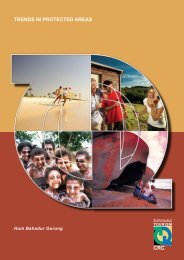icolls - Sustainable Tourism CRC
icolls - Sustainable Tourism CRC
icolls - Sustainable Tourism CRC
You also want an ePaper? Increase the reach of your titles
YUMPU automatically turns print PDFs into web optimized ePapers that Google loves.
ECOLOGY, THREATS AND MANAGEMENT OPTIONS FOR SMALL ESTUARIES AND ICOLLS<br />
humans rely (Flindt et al. 1999). Furthermore, the long-term cycling of nutrients and contaminants within<br />
estuarine sediments has been shown to establish and sustain macroalgal blooms long after additions cease<br />
(McAuliffe et al. 1998; Rozan et al. 2002).<br />
Bioaccumulation of contaminants in fish and macroinvertebrates has led to the closure of numerous<br />
commercial and recreational fishing industries throughout the world. In the USA, 37 states have at some stage<br />
issued health warnings associated with consumption of fish from waterbodies owing to unsafe concentrations of<br />
mercury (Kawaguchi, Porter, Bushek & Jones 1999). Whilst ceased delivery of contaminants can lead to<br />
recovery of these systems, current evidence suggests that this is a very slow process. Kawaguchi et al. (1999)<br />
highlighted this point with the case of Minimata Bay in Japan, which, after being closed for 45 years due to<br />
mercury contamination, had only just been reopened for consumptive harvesting in 1999. In light of these<br />
statistics, there is increasing recognition that ongoing atmospheric and direct delivery of contaminants from<br />
urban, industrial and agricultural sources will threaten the long-term sustainability of fishing in coastal and<br />
inland waterways throughout the world (Cappo et al. 1998; Kawaguchi et al. 1999; Zann 2000). In ICOLLs,<br />
comparatively long water residence times are likely to ensure that contaminant concentrations remain high for<br />
extremely long periods of time (Neira & Potter 1992; Balls et al. 1995; Allanson 2001; Peters & Donohue 2001;<br />
Young & Potter 2002). As a result, fisheries recovery from contaminant pollution is likely to be extremely slow,<br />
possibly with serious impacts on commercial and recreational catches. In instances where contamination is acute,<br />
entire fisheries may collapse and conceivably never recover.<br />
The presence of contaminants in coastal waterways has also been linked to health problems of fish consumers<br />
in many regions of the world, particularly in North America (Hanrahan et al. 1999; Johnson et al. 1999;<br />
Kosatsky et al. 1999; Schantz, Gardiner, Gasior, Sweeney, Humphrey & McCaffrey 1999). In addition to<br />
impaired neurological functioning in children (Schantz et al. 1999), sports fishers who consumed their catches<br />
from the Great Lakes and St. Lawrence River basins have been shown to have reduce fertility (Buck, Mendola,<br />
Vena, Sever, Kostyniak, Greizerstein, Olson & Stephen 1999; Courval, DeHoog, Stein, Tay, He, Humphrey &<br />
Paneth 1999). In response to these serious health concerns, recent studies have identified the need for improved<br />
monitoring programs, public health warnings and fishing restrictions in contaminated waterways (Courval et al.<br />
1999; Falk, Hanrahan, Anderson, Kanarek, Draheim, Needham, Patterson & The Great Lakes Consortium 1999;<br />
Schantz et al. 1999).<br />
In addition to human health concerns, there has been increased interest recently in the ecological<br />
consequences of human pollutants in coastal waterbodies, particularly those that can alter the physiology of<br />
resident organisms. Environmental oestrogen is of particular concern, as high concentrations can have serious<br />
effects on the reproductive success of fish and other aquatic organisms (Robinson, Brown, Craft, Davies, Moffat,<br />
Pirie, Robertson, Stagg & Struthers 2003; Jobling, Casey, Rodgers-Gray, Oehlmann, Schulte-Oehlmann,<br />
Pawlowski, Baunbeck, Turner & Tyler 2004). Similarly, the presence of human bacterial and viral communities<br />
potentially threatens the ecological health of many waterways receiving inputs from STPs and other industrial<br />
pollutants (Riera, Stal & Nieuwenhuize 2000).<br />
Threatening Process 2: Fisheries<br />
In southern Australia, some of the larger ICOLLs support significant commercial and recreational fishing<br />
enterprises (Pollard 1994a; Bell 1997; Roy et al. 2001). In fact, Pollard (1994a) found that two intermittently<br />
open lagoons had larger fisheries (catches in tonnes) than a nearby permanently open lagoon, despite the fact that<br />
they had smaller surface areas and lower diversity of resident fish species. The processes supporting these large<br />
fish populations in ICOLLs are largely unknown, although it is possible that the lower species diversity in<br />
intermittently open systems facilitates higher productivity with regard to species of commercial interest via<br />
reduced competition for resources (Linke, Platell & Potter 2001).<br />
In recent times, there has been a considerable impetus to determine the nursery value of estuarine habitats<br />
around the world (Cappo et al. 1998; Beck, Heck, Able, Childers, Eggleston, Gillanders, Halpern, Hays,<br />
Hoshino, Minello, Orth, Sheridan & Weinstein 2001; Saintilan 2004). Whilst small ICOLLs are unlikely to be<br />
important areas for commercial fisheries, these systems undoubtedly provide nursery habitats for estuarine and<br />
marine species of commercial interest (Bell 1997; Valesini, Potter, Platell & Hyndes 1997). It is generally<br />
accepted that the maintenance of healthy coastal waterways can contribute to the sustainability of commercial<br />
yields of mollusc (oysters), crustacean (prawns and crabs) and fish species (Couch 1989; Loneragan, Bunn &<br />
Kellaway 1997; Blaber et al. 2000; Cowley, Whitfield & Bell 2001; Roy et al. 2001) and as such, the<br />
environmental quality and role of ICOLLs in supporting coastal fisheries deserves more attention.<br />
The importance of ICOLLs in sustaining fish populations is highlighted by the diversity of highly sought<br />
after table fish and crustaceans that inhabit these systems. Some of the invertebrate species particularly abundant<br />
in Australian ICOLLs include prawns (Peneaus spp.), sand crabs (Portunus pelagicus) and mud crabs (Scylla<br />
spp.). Among the fish species, Whiting (Silago ciliata), Mangrove Jack (Lutjanus argentimaculatus), Yellowfin<br />
6











